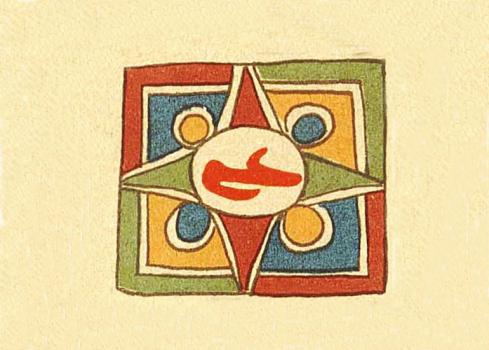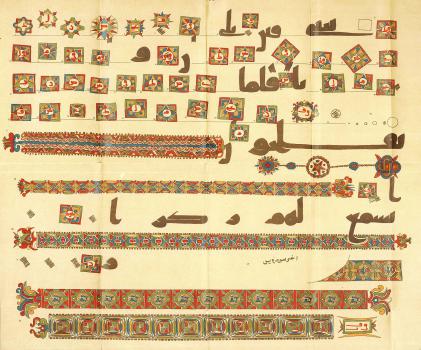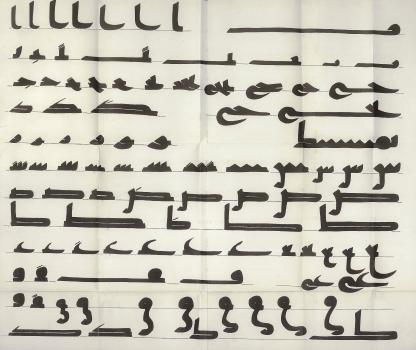Samarkand Quran

O.V. Vasilyeva
Research by A. F. Shebunin
Aleksey Shebunin (1867–1937), a student of the Arabist Viktor Rosen at the Oriental Faculty of St. Petersburg University, graduated from the Educational Department at the Asian Department of the Ministry of Foreign Affairs, later became a diplomat and married the daughter of one of his teachers, the Turkologist Vasily Smirnov, a professor at St. Petersburg University and head of the eastern department of the Public Library. (The daughter of Shebunin and N. V. Smirnova was married to the famous Iranian scholar V. F. Minorsky.) Smirnov and Stasov supported and helped the young scholar, which Shebunin mentions in his study "The Kufic Quran of the Imperial St. Petersburg Library». (In 1891, it was published as a separate print, and, in 1892, in the 6th volume of the ""Proceedings of the Eastern Branch of the Imperial Russian Archaeological Society".) It includes historical materials: a letter from K. P. von Kaufmann to the Minister of Public Education with a description of the circumstances of the acquisition of the Quran and with a request to transfer it to the Public Library, the text of a note compiled by the ulema of the Khwaja Ahrar Mosque, an extract by N. I. Veselovsky from the archives.
Next goes a description of the "the external appearance", from which we learn that the manuscript has 353 leaves measuring 68 cm wide (horizontal size) and 53 cm high (vertical size), the text covers an area of 50 x 44 cm. Most leaves are smooth parchment (specially processed skin), and 69 were replaced by sheets of thick paper glued in the middle of two parts. The hair side of the parchment is yellow, the flesh side is white, "with small wrinkles". In most cases, the front sides of the leaves are the flesh side of the parchment. This does not follow the so-called Gregory's rule of arranging parchment leaves so that the hair side faces the hair side, and the flesh side faces the flesh side. On most of the front (flesh) sides of the parchment, the ink crumbled off, but on the smooth back (hair) sides, they were well preserved. Ink is dark brown, but Shebunin believes that they were originally black, that is, produced from soot (brown is a sign of the presence of iron in the ink).
The text on paper leaves is carefully written out in the same script as on parchment. Damage and loss of parchment were glued with patches of the same paper. Much later, both parchment and paper leaves were reinforced by backing each leaf with another sheet of thin glossy paper, while only 15 leaves remained completely unrenovated.
In the manuscript, a gathering, or quire, was initially formed of 4 – 5 folded sheets of parchment, i.e. 8 – 10 leaves, however, after the last sewing, the leaves turned out in wrong sequence. From the description of the content of the Qur'an, it follows that it begins with verse 6 of Chapter 2 (Surah 2), there are gaps in the text, the end is missing.
Each page contains a maximum of 12 lines of large Kufic writing, but in some places the letters become smaller. Shebunin pays much attention to the features of handwriting, notes the presence of word wrapping from line to line and the absence of superscript and subscript characters except for diacritical dashes-dots. Verses are often, but not always, marked by groups of dashes. The markers between dozens of verses (there are 151 in total) are a star inscribed in a square with a side of 2.5-3 cm. Inside a star is a circle with a diameter of 1 cm, containing an arabic letter sranding for a number of tens in a chapter. These markers are painted in red-crimson, green, blue and orange which are also used for five horizontal headpeaces marking chapters (in other cases, blank lines were left). Shebunin makes a conclusion that colorful decorative elements were added to the text much later, but does not dare to guess when exactly. This is a contradiction to the assumption of Stasov who dated the ornament to the 8th century.
Further, the author studies the handwriting, discovers corrections and "erasures" which are often made by the scribe of the Quran, but there are also later corrections. In the last chapter, he is talking about a one-time complete restoration of the Quran, during which crumbling ink were recoverd on the flesh side of the parchment, lost or damaged parchment leaves were replaced or reinforced with paper ones, and the text was carefully reproduced on them. While working, the restorer tried very hard to replicate the writing of the original, but made minor mistakes, omissions, increased or decreased the number of lines. Shebunin quotes a passage about Mullah Gabdrakhim (Abd al-Rahim) Utyz Imyani, from the above-mentioned work by Märcani and suggests that it was he who did the complete restoration of the Quran, and this happened in the first third of the 19th century. (In fact, this could have happened no later than 1805.) However, the question remains when and where the re-restoration was carried out – reinforcing both parchment and paper leaves with thinner paper and sewing a block in which the leaves were mixed up?
Finally, Shebunin, listing the arguments, comes to the final conclusion that the Samarkand Quran was copied at the early 2nd century AH (after 720) in Iraq, since its writing is closer to the Basran copy than to the rest of the most oldest Damascus, Meccan ("of Mecca"), Medinan ("of Medina") and Kufic Qurans. The Samarkand Quran is likely a copy, direct or indirect, of the Quran from Basra. At the end of the book there are explanations to the tables and spreadsheets themselves, which provide individual pages, writing samples and decorative elements reproduced in color.
It should be noted that A. F. Shebunin, at the age of 24, managed to do an in-depth research in the field of Arabic paleography, a science that was still in its infancy. His research has not lost its value to this day. Ten years later, Shebunin, who held the post of secretary of the Russian consulate in Cairo at that time, issued the results of studying another ancient copy, titled "The Kufic Quran of the Khedive Library in Cairo." (in 1902, in the 14th volume of ""Proceedings of the Eastern Branch of the Eastern Branch of the Imperial Russian Archaeological Society" and as a separate print). Shebunin noted the Cairo Quran (now in the National Library of Egypt) is surprisingly similar to the Samarkand manuscript both in size, and in the number of lines, and in the quality of parchment, and in handwriting. Naturally, in his new work, he gave a comparative analysis of two ancient manuscripts, clearly demonstrating the similarity of their writing styles in the attached tables.





